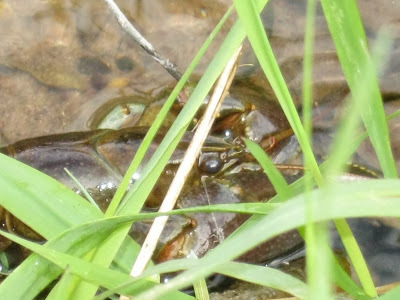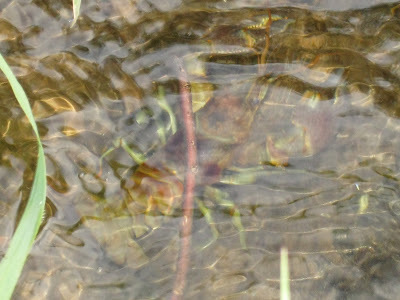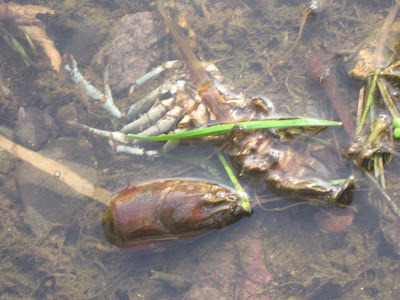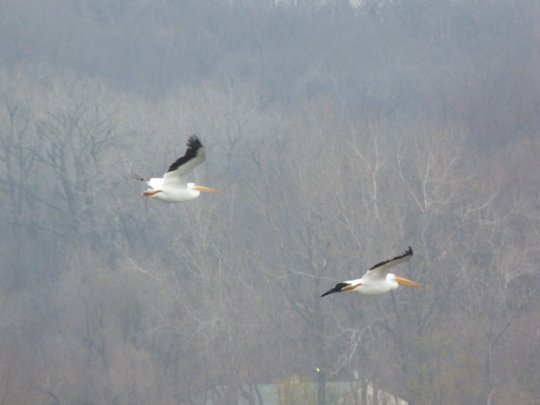Gordon Grice's Blog, page 47
August 9, 2012
Animal Attack Movies: Them!

Them! (Gordon Douglas, 1954)
We watch through binoculars as a giant ant drops a human rib cage. It tumbles down the anthill. For me, the horror of this moment is exceeded only by the joy of recognition, for I’ve spent many a slow morning squatting near the dens of harvester ants and watching them clear out their own dead. Giant bug movies proliferated like cockroaches in the 1950s. It’s a famously cheesy genre, but it did produce some gems, like Jack Arnold’s beautifully photographed Tarantula. Them! is the best of the buggy bunch.
No one who has ever studied ants has failed to imagine the premise of this movie—the sizes of our two social species somehow evened. We humans would win if we were allowed high-tech weapons—the people in the movie use flamethrowers. But the harvester ant has a mighty sting, among the most painful in North America—as I can personally attest. In a fair fight, we’d have no chance. Of course, harvester ants probably wouldn’t be interested in hurting us without provocation. They prefer seeds to meat.

Published on August 09, 2012 01:00
August 8, 2012
Crawdad Creek
Published on August 08, 2012 03:00
August 6, 2012
Tarzan vs. the Hyaenadons

A couple of scans from the Tarzan comic book I mentioned last week. Borrowing an idea from Arthur Conan Doyle, creator Russ Manning has his protagonists on a plateau that time forgot, populated by prehistoric mammals: giant warthogs, a saber-toothed cat, a megatherium. The hyaenadons, as conceived by Manning, look and behave a lot like modern spotted hyenas. Hyaenodons were real, though they are now classed as creodonts, primitive carnivores not closely related to hyenas.

Related Posts:
Cheetah the Chimp Dies?
Tarzan and His Mate

Published on August 06, 2012 22:30
August 5, 2012
Two Kinds of Oven-Bird

Red Ovenbird
(Furnarius rufus)
William Henry Hudson
At frequent intervals during the day the male and female meet and express their joy in clear, resonant notes sung in concert—a habit common to species which pair for life. In a majority of species this vocal performance merely consists of a succession of confused notes or cries, uttered with great spirit and emphasis; in the Oven-bird it has developed into a kind of harmonious singing. Thus, the first bird, on the appearance of its mate flying to the place of meeting, emits loud, measured notes, sometimes a continuous trilling note with a somewhat hollow, metallic sound; but immediately on the other bird joining, this introductory passage is changed to rapid triplets, strongly accented on the first and last notes, while the second bird utters a series of loud measured notes perfectly according with the triplets of the first. While thus singing they stand facing each other, their necks outstretched, wings hanging, and tails spread, the first bird trembling with its rapid utterances, the second beating on the branch with its wings. The finale consists of three or four notes uttered by the second bird alone, and becoming successively louder and more piercing until the end. There is an infinite variety in the tone in which different couples sing, also in the order in which the different notes are uttered, and even the same couple do not repeat their duet in precisely the same way; but it is always a rhythmical and, to some extent, an harmonious performance, and as the voices have a ringing, joyous character, it produces a pleasing effect on the mind.
In favourable seasons the Oven-birds begin building in the autumn, and the work is resumed during the winter whenever there is a spell of mild, wet weather. Some of their structures are finished early in winter, others not until spring, everything depending on the weather and the condition of the birds. In cold, dry weather, and when food is scarce, they do not work at all. The site chosen is a stout horizontal branch, or the top of a post, and they also frequently build on the roof of a house ; and sometimes, but rarely, on the ground. The material used is mud, with the addition of horsehair or slender fibrous rootlets, which make the structure harder and prevent it from cracking. I have frequently seen a bird, engaged in building, first pick up a thread or hair, then repair to a puddle, where it was worked into a pellet of mud about the size of a filbert, then carried to the nest. When finished the structure is shaped outwardly like a baker's oven, only with a deeper and narrower entrance.
It is always placed very conspicuously, and with the entrance facing a building, if one be near, or if at a roadside it looks toward the road; the reason for this being, no doubt, that the bird keeps a cautious eye on the movements of people near it while building, and so leaves the nest opened and unfinished on that side until the last, and there the entrance is necessarily formed. When the structure has assumed the globular form with only a narrow opening, the wall on one side is curved inwards, reaching from the floor to the dome, and at the inner extremity an aperture is left to admit the bird to the interior or second chamber, in which the eggs are laid. A man's hand fits easily into the first or entrance chamber, but cannot be twisted about so as to reach the eggs in the interior cavity, the entrance being so small and high up. The interior is lined with dry, soft grass, and five white pear-shaped eggs are laid. The oven is a foot or more in diameter, and is sometimes very massive, weighing eight or nine pounds, and so strong that, unless loosened by the swaying of the branch, it often remains unharmed for two or three years. The birds incubate by turns, and when one returns from the feeding-ground it sings its loud notes, on which the sitting bird rushes forth to join in the joyous chorus, and then flies away, the other taking its place on the eggs. The young are exceedingly garrulous, and when only half-fledged may be heard practising trills and duets in their secure oven, in shrill tremulous voices, which change to the usual hunger-cry of young birds when the parent enters with food. After leaving the nest, the old and young birds live for two or three months together, only one brood being raised in each year. A new oven is built every year, and I have more than once seen a second oven built on the top of the first, when this has been placed very advantageously, as on a projection and against a wall.
A very curious thing occurred at the estancia house of a neighbour of mine in Buenos Ayres one spring. A pair of Oven-birds built their oven on a beam-end projecting from the wall of a rancho. One morning one of the birds was found caught in a steel trap placed the evening before for rats, and both of its legs were crushed above the knee. On being liberated it flew up to and entered the oven, where it bled to death, no doubt, for it did not come out again. Its mate remained two days, calling incessantly, but there were no other birds of its kind in the place, and it eventually disappeared. Three days later it returned with a new mate, and immediately the two birds began carrying pellets of mud to the oven, with which they plastered up the entrance. Afterwards they built a second oven, using the sepulchre of the dead bird for its foundation, and here they reared their young.
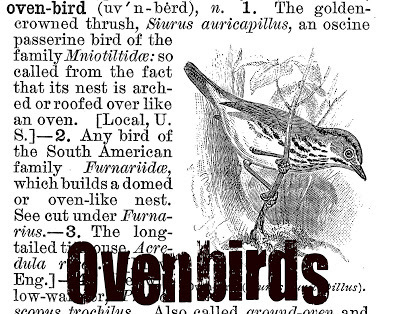
The Oven Bird
(Seiurus aurocapillus)
Robert Frost
There is a singer everyone has heard,
Loud, a mid-summer and a mid-wood bird,
Who makes the solid tree trunks sound again.
He says that leaves are old and that for flowers
Mid-summer is to spring as one to ten.
He says the early petal-fall is past
When pear and cherry bloom went down in showers
On sunny days a moment overcast;
And comes that other fall we name the fall.
He says the highway dust is over all.
The bird would cease and be as other birds
But that he knows in singing not to sing.
The question that he frames in all but words
Is what to make of a diminished thing.

Published on August 05, 2012 23:30
Rat Snake on Tree Trunk

"The Rat Snake was a beauty, at least 6 feet (probably more along the lines of 7 or so if she had not been clinging to that tree for dear life) and freshly shed and so shiny I wanted to touch her. She was very observant of me, but she did not show any defensive posturing and I was able to get within 4 foot or so of her. As soon as I walked away, she turned and made her way back up to the top of the tree."
--Dee Puett, Photographer





Published on August 05, 2012 03:00
August 4, 2012
Hand-Wringing from Utah: Rattlesnake Invasion
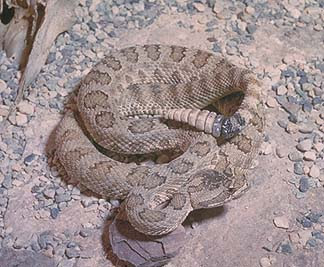
A story of a kid who got bitten by a snake and suffered mild symptoms:
After suffering attack, young boy's family warns of rattlesnake dangers | ksl.com:
"9-year-old Tyler Perry was looking on July 13 for a pheasant that had escaped its pen in his family's back yard in Grantsville, and he found a hole — the opening of an old irrigation pipe just beyond a fence.
"I bent down to look for the pheasant in the hole and I got bit by a rattlesnake," Perry told KSL."
All this talk of snakes invading "neighborhoods" strikes me as bizarre. In the video report, I'm seeing hills, brush country, horses in a corral. If your "neighborhood" is the country, can you really be surprised about finding wildlife in it?
In another report, the same station mentions that rattlesnake sightings have been unusually frequent this year:
Rattlesnake sightings abound in Layton foothills | ksl.com:
"Animal Control officers say the number of complaints for the dangerous reptiles is way up this year. According to experts, a number of factors could be the cause, including the heat, wildfires, and even a very wet spring last year. Either way, 2012 is shaping up to be the biggest year for snake activity in northern Utah in a long time."
I really doubt these "reporters" have the records to prove that last claim. However, as mentioned in The Red Hourglass, animal populations do run in cycles influenced by the weather.

Published on August 04, 2012 02:30
August 2, 2012
A Bounty on Bull Sharks

Demonstrating a poor grasp of statistics, the French government has put a bounty on bull sharks. This follows the death last week of a surfer. The shark bit the surfer's leg off. I see news articles every year claiming shark attacks are on the rise, all false. "Three fatalities in two years" is hardly a trend.
Deaths spur French gov't to pay for shark hunt - CBS News:
"From 2000 to 2010, there were no shark attacks off Reunion and no calls for culling, but the last two years have seen several deadly attacks, the most recent coming last week when a 22-year-old surfer died after a shark bit off his leg. It was the seventh attack — and the third fatality — since the start of last year."

Published on August 02, 2012 21:03
August 1, 2012
Hand-Wringing from Pennsylvania: Black Widow Invasion
abc27 WHTM
This clip shows why nobody respects TV news. As reader Steve V. pointed out in an email, this would hardly be considered an "infestation" elsewhere. I love how the news anchors say spiders are creepy, as if that were a newsworthy fact.
Black widow spider populations come and go, so this is hardly an epic event. The important idea buried in all this, however, is that it's not as cold as it used to be. People will be seeing animals they aren't used to as the globe warms up.
A more sensible reaction to seeing a black widow is, of course, to photograph it and send the images to some humble blogger who will appreciate them. That's the course of action recently chosen by Hodari Nundu:
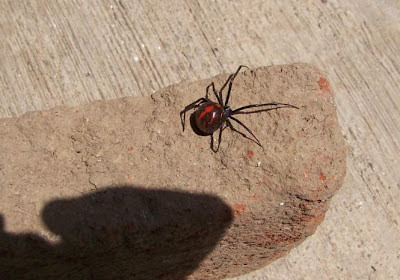



Photography by Hodari Nundu
More than you'll ever want to know about black widows:


This clip shows why nobody respects TV news. As reader Steve V. pointed out in an email, this would hardly be considered an "infestation" elsewhere. I love how the news anchors say spiders are creepy, as if that were a newsworthy fact.
Black widow spider populations come and go, so this is hardly an epic event. The important idea buried in all this, however, is that it's not as cold as it used to be. People will be seeing animals they aren't used to as the globe warms up.
A more sensible reaction to seeing a black widow is, of course, to photograph it and send the images to some humble blogger who will appreciate them. That's the course of action recently chosen by Hodari Nundu:




Photography by Hodari Nundu
More than you'll ever want to know about black widows:

Published on August 01, 2012 22:05
Please Don't Feed the Alligators
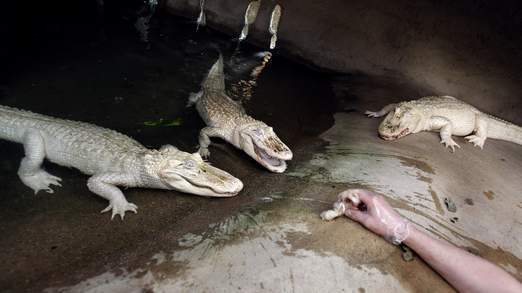
Man Charged After Alligator Eats His Hand:
"Weatherholt hung a fish over the side of a boat and had his hand at the water's surface when the nine-foot long animal attacked.
Wildlife officers tracked down and killed the alligator.
Weatherholt's hand was found too, but it could not be reattached."
I assume the pasty-looking fellows in the photo are being fed in a zoo.

Published on August 01, 2012 02:30
July 30, 2012
American White Pelicans
Published on July 30, 2012 22:30



